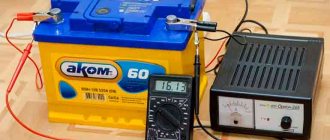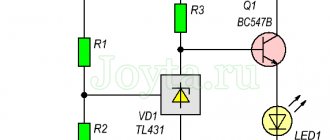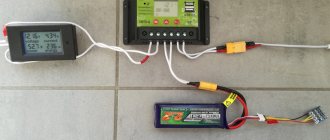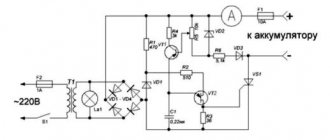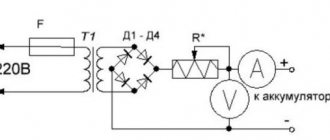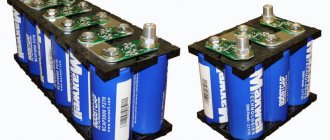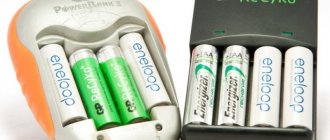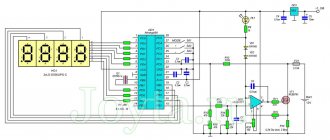Battery capacity is an important parameter for calculating the power of an autonomous solar system. Its value is calculated before purchasing equipment.
The choice of battery directly depends not only on the daily rate of energy consumption, but also on the intensity with which they are intended to be used. This can be a constant operating mode (cyclical, when the battery is regularly charged/discharged) or a buffer mode (backup), which supplies energy to the home network if the external network is turned off.
If the battery will continue to operate continuously, it is best to use gel batteries and wet batteries. Acid batteries are suitable for backup power.
It doesn’t matter whether you bought a battery or are still faced with a choice, in any case, please note that sealed maintenance-free batteries (those that do not need to be periodically topped up with water and electrolytes to replenish their service life) are recommended to be discharged no more than 40%, starter batteries imply the use of no more than 50% of all accumulated energy.
The service life of each battery is designed to perform certain charge/discharge cycles. For example, discharging the battery by 30% provides battery performance equal to 1000 cycles. When discharged to 70%, the battery performs 700 cycles. A 100% discharge can completely destroy the battery after completing a small number of cycles.
Battery life calculation
So how do you calculate battery life? Battery capacity is often indicated in ampere-hours, or mAh. It seems nothing complicated, because you have everything, let’s say, a battery with a capacity (C) of 800 mAh for hours and a device with a current consumption (I) of 100 mAh, which means, according to the formula, it can ensure the operation of this device for 8 hours. So? Not really. The amount of electrical energy that can be extracted from the battery depends on the battery discharge current. That is, with a fairly large discharge current, the battery runs out at lightning speed and releases little energy.
This phenomenon was noticed many years ago, but the first person to try to take it into account quantitatively was Peukert, who modified the formula. According to Peukert, the battery discharge time is equal to, where n is the Peukert exponent. Сp – Peukert capacity. I – discharge current. The value of the Peukert exponent can be determined experimentally. It depends on the type of unit and even on its release. Basically, this value lies in the range from 1.1 to 1.3.
For some batteries, the manufacturer indicates it, but this does not happen often. Basically, you can notice the battery capacity data for different discharge times. This is basically enough to find out the value of the Peukert exponent yourself. So you’ve learned how to calculate how long your battery will last.
How long will the battery last to operate the inverter?
So how do you calculate how long your battery will last? Theoretically, in each specific situation, the operating time of the inverter should be calculated separately, based on the following factors:
- Battery capacities.
- Condition of the unit, level of wear and charge.
- Operating conditions.
- The power of the connected devices and the current they absorb.
- Type of load and volume.
But even if everything is taken into account, it is difficult to accurately calculate the operating time of the inverter. Calculating the battery for an inverter without starting the engine using formulas is often quite inaccurate. First of all, because there is no linear dependence in the drop in battery voltage to the minimum permissible values.
This is all because during the operation of the inverter, the battery is affected by many important factors. But, one way or another, calculation using the formula is quite possible. For example and clarity of calculations of the inverter operating time, we use the following data:
- Battery capacity is 60 ampere-hours.
- Powered device, Lenovo G550 laptop.
Input type voltage, which has 19 watts, absorbed current - 3.42 A, power - 19x3.42 = 64.98 watts (rounded to 65). An inverter for a car most often has an efficiency of about 85%, it turns out that if a load of 100 V is connected to it, then it will absorb 115 V from the battery. We calculate the operating time using the formula T (hour) = Ah (amp-hour) x V ( volts) x N (0.85) x K (coefficient 0.5 or 0.25) / P (V), in which:
- T is the operating time of the connected device in hours. Ah is the vehicle battery capacity per ampere hour. V - min. voltage in volts.
- N - efficiency of the inverter device, take the value of 85%, in the formula - 0.85.
- K - max. percentage of the permissible degree of battery discharge depending on the air temperature: 0.5 or 0.25.
- P is the power of the device connected to the inverter in watts.
The result is: for warm weather conditions: T = 60x11.6x0.85x0.5/65 = 4.5 or four hours and thirty minutes, for sub-zero temperatures: T = 60x12x0.85x0.25/65 = 2.3 or two hours and eighteen minutes.
If you have trouble calculating battery life and don't understand the formulas, use a helper. The calculator will immediately solve all your problems, the main thing is to enter the data correctly.
What is battery capacity
This parameter determines the amount of time during which the battery is capable of delivering the electricity previously accumulated as a result of charging. This indicator is equally important for both a car battery and a finger-type battery from a player or camera. The same applies to cell phone power supplies.
Especially big troubles can happen if you take the wrong container for your car battery. Firstly, the capacity may not be enough to power the on-board network when the engine is not running; the worst thing is that there may be problems with starting in the winter. Every motorist should have an idea of how to calculate battery capacity.
Comprehensive information about this parameter of a modern power source can be obtained by looking at its labeling. For example, 1200 mAh (1200 milliamp-hours), 60 Ah (60 ampere-hours). Unlike the capacitance of a capacitor, which is measured in farads, the battery uses an off-system unit of measurement - Ah (Ampere hour). There is a clock in this unit of measurement because, unlike a capacitor, which discharges instantly, a battery is designed to provide power for a fairly long time.
The capacity of this battery is 60 ampere-hours
Capacity, expressed in ampere-hours, indicates how long a given battery is capable of powering a load with a specified current consumption.
Note! What does an abbreviation like 30 Ah mean? A fully charged battery with a capacity of 30 ampere-hour can operate for one hour, supporting a network load of 30 A with a nominal voltage of 12.7 V.
30 A is a fairly large current value; at a voltage of 12.7 V, the battery power will be: I*V=30*12.7=0.381 kW. This power is enough to illuminate the entire house during the day if there are LED lamps, which consume from 3 to 5 W per hour of operation. The operating time is inversely related to the load current: the lower it is, the longer the battery can support the network. If the load current is 10 A, it will work for 3 hours, if 5 A, then 6 hours.
Cell phone battery
The battery capacity of a cell phone ranges from 500 to 2000 mAh. Such a battery will allow the phone or smartphone to work in active mode for a week. In this case, it is necessary to take into account the activity of the user himself: if a person talks on the phone for more than an hour every day, uses an alarm clock, and various games, then the largest capacity will be enough for a day or two.
Additional Information . Calculation of the total battery capacity is only possible empirically. When it works out the required ampere hours indicated on the marking, this does not mean that after that it is no longer capable of producing electricity. Without recharging, the battery is still capable of generating electrical energy for quite a long time. However, the current will not be sufficient for the purpose for which it is used.
User Experience
Battery problems worried me two years ago, when I didn’t have a license. At first I couldn’t determine its capacity, but then I figured it out. The school offered to do a project on a free topic. I decided to study the correspondence of the parameters indicated on batteries from different manufacturers with their actual characteristics. I did this as a hobby, I did everything for the sake of interest. I didn’t think it would be useful later when I started driving.
Of course, I no longer completely discharge batteries; I use more advanced methods. I always plug in a solid-state relay so that there is no need to completely discharge the drive.
Alexander Kazakov
This is a simple procedure, because the formula for battery capacity is studied in the eighth grade. Of course, not everyone loves physics during their school years and believes that it will not be useful to them in life. But most guys, and girls too, then get behind the wheel
When driving and caring for a car, it is important to understand the basics of mechanics and electricity, so physics should not be neglected. But some people simply forget the acquired knowledge or cannot apply it in practice
However, even those who did not study at school sometimes know the formula for current strength: I = U/R. When this parameter is known, it is enough to multiply it by the operating time.
Victor Shkurapetov
I always take measurements using a full discharge. I believe that this is the only method that gives reliable results, so I only recommend it. Of course, sometimes it’s inconvenient to charge a device for several hours, especially with a large capacity, like in cars. However, I still don’t see an alternative. Moreover, a machine is a mechanism whose serviceability must be carefully monitored. No one would want to be left without lamp light at night or in the fog, because this person would have to wait either for the morning or for the help of fellow motorists. Both options are not a very pleasant pastime.
Andrey Kolegov
How many ampere hours does a car battery have?
Battery capacity is a variable value, depending on the individual characteristics of the battery. Usually the battery is assembled in series, which means the capacity is measured according to the weakest bank. The voltage is summed up.
It is known that liquid acid batteries have 6 cans, each of them carries a voltage of 2.1 - 2.15 V. Capacity is the amount of energy in ampere-hours stored in the battery. This indicator is a passport characteristic.
You can find the actual capacity by measuring the energy output from a full charge to the minimum possible discharge at a constant current and resistance. Time and current strength are recorded. Their product determines the battery capacity in ampere hours. The indicator will differ from the passport value, since the battery capacity is constantly decreasing due to additional chemical reactions.
Product categories
- EPSolar solar charge controllers MPPT (1)
- Goal Zero Folding Solar Panels (2)
- Li-ion UPS and battery (8)
- MPPT Charge Controllers (40) Delta solar charge controllers MPPT (5)
- EPSolar solar charge controllers MPPT (20)
- I-Panda Solar Charge Controllers MPPT (3)
- JUTA solar charge controllers MPPT (3)
- Schneider Electric solar charge controllers MPPT (2)
- SRNE solar charge controllers MPPT (7)
- Stark Country INV (4)
- Chilwee batteries (30) DZM series (10)
- Series A (8)
- Carbon CDG Series (4)
- FT Series (10)
- Series MM (13)
- OP Series (8)
- GL Series (4)
- GPL Series (7)
- GST Series (3)
- VOSTOK PRO Series CK (15)
- Active charge equalizers (3)
- Ecovolt series Solar battery inverters (3)
- Boilers "Drazice" with enamel coating (4)
- BRAUDER hybrid inverters (1)
- Sets of autonomous two-way traffic lights T 7.1 (38)
- Autonomous solar power plants (6)
- AcmePower inverters (14)
- AcmePower inverters (7)
- AcmePower UPS (8)
- MPPT Charge Controllers (2)
- Delta BST Monocrystalline Solar Panels (9)
- Delta BST Polycrystalline Solar Panels (6)
- Size II (4)
- IP65 Weatherproof Electrical Box for Pole and Wall Mounting (1)
- GoodWe grid inverters (3)
- LED light bar (1)
- Boilers and buffer tanks (2)
- Flexible solar panels (2)
- EcoFlow Folding Solar Panels (1)
- Infrared gas heater Ballu BIGH (6)
- Delta solar charge controllers "PWM" (8)
- Inverters Energy UPS PRO (7)
Monoblock
You can assemble a battery from individual batteries using a copper wire or a bus bar with terminals. This process, although simple, is still quite labor-intensive, so ready-made monoblocks are made in factories. They consist of several elements assembled in one case made of durable plastic. Monoblock lead-acid batteries typically consist of 6 or 12 individual cells. The voltage is 12 V or 24 V, respectively.
Monoblock
All elements of the monoblock are no different from each other, and they age simultaneously, so the service life of the monoblock is longer than that of each individual battery. In the process of assembling a monoblock, it is possible to use both parallel and serial connections of its individual elements.
Note! Battery life is measured not in years or months, but in the number of charging cycles. To ensure that the battery lasts as long as possible, it is advisable to recharge it after using only a small part of its rated capacity.
Battery and battery
How to check battery capacity with a multimeter
How to increase the capacity of the power supply? The simplest and most obvious way is to increase the substance involved in the chemical reaction. At the same time, the current will increase, and the process of generating electricity will take longer, that is, the number of ampere-hours will increase. However, this method cannot always be applied in practice. It is not always possible to obtain the calculated capacity by increasing or decreasing the amount of reagents.
The fact is that even if the battery is of the largest size, and a huge amount of lithium is spent on its production, the voltage of the generated electricity will not increase at all. This indicator is inherent in the very basis of a chemical reaction. For an acid battery it is 2 V, for a lithium-ion battery it is 3.7 V.
So how do you get the 12 V needed to start a car engine? To do this, you need to combine the batteries into a battery. For example, connect 6 lead-acid batteries with a voltage of 2 V in series with each other.
There are two ways to connect batteries:
- series, at which the voltage increases, while the capacitance remains unchanged;
- parallel, when the number of ampere hours increases, the voltage remains constant.
The capacity of a battery, as well as its voltage, is easy to calculate; you may not even need a regular calculator for this. If, for example, two acid batteries with a capacity of 1 Ah are connected in parallel, the capacity will actually double at a constant voltage. When they are connected in series, the opposite will happen: the voltage will increase by 2 times, the capacitance will remain the same. In both cases, the amount of electricity from two power sources will double.
How to check the battery when purchasing?
Having selected the desired battery, do not forget to check its performance. This can be done simply by connecting a load plug to it. With its help, you measure the voltage at idle and under load. Every self-respecting store should have a loading fork! Don't have such a device? Consider purchasing your battery elsewhere.
All batteries are divided into three categories:
1. Serviceable or repairable batteries - devices that were in demand a few years ago are not so popular today. The battery case is made of ebonite, filled with mastic on top.
2. The batteries are maintenance-free. This type of battery is designed to work under ideal conditions.
3. For our realities, the most suitable type of batteries is low-maintenance. They are distinguished by a favorable price, good quality and a long service life.
When choosing a battery, you need to find out its release date. As noted earlier, the battery life is 3-5 years; naturally, the newer the device, the longer it will last. By the way, this period begins to be calculated not from the day it is installed in the car, but from the moment the electrolyte is filled.
The cost of a battery is directly proportional to its starting current capacity. The larger the battery capacity, the faster the starter will crank the car engine.
It is better to buy batteries in specialized stores. Professional consultants will competently select the battery for your car. In such stores you will buy a genuine certified product, and if a defect is detected, your device will be replaced. But, when purchasing, be sure to check that the warranty card and the issued receipt are filled out correctly.
Is it possible to increase the capacity
The battery capacity can be increased only slightly. In general, this process has two sides to the “coin”:
- On the one hand, this is necessary if additional electrical equipment is connected to the on-board network. In addition, in the cold season, the capacity reserve is very useful, because when the air temperature decreases by one degree, the power correspondingly decreases by 1 Ah.
- On the other hand, when not operating in standard mode, the starter is subject to greater wear. And also the generator characteristics may not be sufficient to fully charge the battery.
What affects the battery capacity under real operating conditions?
The actual capacity of a car battery, as a rule, differs from the nominal one. The longer the battery life, the more significant its reduction. There are several reasons that provoke this process:
- terms of Use;
- features of meeting deadlines and service technology;
- battery charging method.
Recommendations for selection
Most often, vehicle owners, when choosing, focus on the size of the power plant. You can use a special table for this:
It is immediately noticeable that batteries with a capacity of 50 to 65 Ah are most often used for installation in passenger cars. If the battery is selected for an SUV, then this parameter should be in the range of 70–90 Ah. You should also remember two nuances, because of which it is worth taking a battery with a slightly larger capacity:
- There are a large number of energy consumers in the on-board network.
- The car has a diesel power plant.
In winter, this reserve will help start the engine without unnecessary problems. However, you should not use a battery with a very high capacity. This is due to the fact that the on-board network is designed to work with batteries that have certain electrical characteristics. As a result, the generator will not be able to fully charge such a battery. In addition, the starter will also work under strain, which can lead to its premature failure.
Internal resistance
Internal resistance is also a fairly important parameter of the battery. The unit of internal resistance is milliohm (mOhm). Resistance, in turn, depends on the capacity of one battery cell (cell), the number of these cells, the type of battery, service life and operating conditions. The internal resistance is determined using analyzer devices.
As the battery operates, the internal resistance gradually increases. If the battery has a resistance of as much as 500 ohms, then we can conclude that it is very old or has simply been used incorrectly.
High internal resistance leads to increased energy consumption and, as a consequence, to shorter operating time of devices, since, according to Ohm's law, high resistance significantly increases current consumption and a simultaneous voltage drop. And if there is a strong voltage drop, the connected electrical appliance mistakes the battery for a discharged one or simply for one that is not able to work. As a result, the battery cannot release all the stored energy, which significantly reduces the operating time of electrical appliances.
Battery self-discharge is the spontaneous loss of electricity from a charged battery over a period of time. Almost all types of batteries are susceptible to this phenomenon, regardless of their design and electrochemical type.
To quantify self-discharge, the amount of energy that a battery loses over a certain period of time is used, and it is calculated as a percentage of the size of a fully charged battery. The amount of self-discharge is not constant; for example, in the first day after charging it reaches maximum values, and then gradually decreases.
In this regard, it is customary to measure the amount of self-discharge on the first day, and then a month after charging. Self-discharge is also influenced by ambient temperature, and the relationship between the magnitude of self-discharge and temperature is proportional. This means that as the temperature increases, the amount of self-discharge also increases.
For example, for some types of batteries, when the temperature rises from 20 to 30 degrees, the self-discharge value doubles. If we talk about its more specific values, then for Ni-Cd type batteries the normal value is 10% per day, and Ni-MH type batteries have a slightly larger self-discharge value, for Li-Ion and for Li-Pol this value is so small that it is assessed only a month after the charge. As for the monthly self-discharge value, for the same types of batteries we have the following parameters:
- Ni-Cd - 20%
- Ni-MH - 30%
- Li-Ion - 10%
These figures are statistical averages and may differ slightly for each specific battery.
To determine the service life of a battery, use the number of cycles between charge and discharge of the battery, which it is able to withstand during operation, without significantly changing its main parameters, such as capacity, self-discharge value, and internal resistance.
The time that has elapsed since the battery was manufactured is also taken into account. If the capacity decreases to 60% of the nominal value, the battery is considered failed. The service life is influenced by a variety of factors:
- battery type
- charging method
- terms of Use
- correct service
Depending on the electrochemical system used, all batteries are divided into the following types:
- SLA/Pb - classic lead-acid
- Ni-Cd - nickel-cadmium
- Ni-MH - nickel metal hydride
- Li-Ion - lithium-ion
- Li-Pol - lithium polymer, which is a relatively new word in modern technology.
What determines the battery capacity?
Discharge current
Typically, the manufacturer assigns the nominal capacity of a lead-acid battery for long-term (10, 20 or 100 hours) discharges. The battery capacity at such discharges is designated as C10, C20 or C100. We can calculate the current flowing through the load during a 20-hour (for example) discharge - I20:
I20 [A] = E20 [A*hour] / 20[hour]
Does this mean that with a 15-minute (1/4 hour) discharge the current will be equal to E20 x 4? No, that's not true. With a 15-minute discharge, the capacity of a lead-acid battery is typically just under half its rated capacity. Therefore, the current I0.25 does not exceed E20 x 2. That is The discharge current and discharge time of a lead battery are not proportional to each other.
The dependence of the discharge time on the discharge current is close to a power law. In particular, Peukert's formula (law) is widespread - named after the German scientist Peukert. Peukert found that:
I p * T = const
Here p is the Peukert number - an exponent that is constant for a given battery or type of battery. Peukert's formula also applies to modern sealed lead acid batteries.
For lead-acid batteries, the Peukert number typically ranges from 1.15 to 1.35. The value of the constant on the right side of the equation can be determined from the nominal capacity of the battery. Then, after several transformations, we obtain a formula for the battery capacity E at an arbitrary discharge current I:
E = En * (In / I)p-1
Here En is the nominal capacity of the battery, and In is the discharge current at which the nominal capacity is set (usually a 20-hour or 10-hour discharge current).
Final discharge voltage
As the battery discharges, the voltage drops. When the final discharge voltage is reached, the battery is disconnected. The lower the final discharge voltage, the greater the battery capacity. The battery manufacturer sets the minimum permissible final discharge voltage (it depends on the discharge current). If the battery voltage drops below this value (deep discharge), the battery may fail.
Temperature
When the temperature rises from 20 to 40 degrees Celsius, the capacity of a lead battery increases by about 5%. When the temperature decreases from 20 to 0 degrees Celsius, the battery capacity decreases by approximately 15%. When the temperature decreases by another 20 degrees, the battery capacity drops by another 25%.
Battery wear
The capacity of a lead-acid battery as delivered may be slightly more or slightly less than the nominal capacity. After several discharge-charge cycles or several weeks of being under a “floating” charge (in a buffer), the battery capacity increases. With further use or storage of the battery, the battery capacity decreases - the battery wears out, ages and eventually must be replaced with a new battery. To replace the battery on time, it is better to monitor battery wear using a modern battery capacity tester - the “Pendant” lead battery capacity indicator
How to find out the battery capacity?
When choosing a phone, some users really pay attention to such an indicator as capacity. With it, they are confident that they will be able to choose a more durable device that will delight them without recharging for a longer period of time.
You can find out the capacity in the technical characteristics of the device (they can be seen both in a regular store on display with the phone and in online stores) upon purchase, and simply look at it by removing the back cover of the phone yourself. Under it you will see the battery label - the manufacturer, certificate and, of course, its capacity will be indicated there (in mAh or mAh - this is the same thing).
Why know the battery capacity?
Energy intensity is the main characteristic of a battery, which is looked at when purchasing. The following factors depend on this indicator:
- power supply price;
- what area is it suitable for?
- approximately how long will it last?
Capacity is the time during which the battery will ensure autonomous operation of the device, giving it energy. In large cells, such as automobiles, it is measured in Ah, in compact ones, for example, for smartphones - in mAh.
When it becomes necessary to find out the battery capacity:
- when looking for a replacement;
- during repairs;
- if you have an old battery that needs to be installed in a new device;
- It is necessary to check the correspondence of the elements.
There are other reasons when it becomes necessary to determine energy intensity. You can do the calculation in several ways, both standard and special. Whichever is more convenient for you.
How is capacity calculated?
When calculating the battery capacity, you need to remember that the battery cannot be completely discharged - you should leave at least 30% of its charge. The value of this parameter must satisfy the needs of the vehicle’s autonomous power supply system.
Let's look at an example of how to correctly calculate the battery capacity. Let’s say the total power of the car’s electrical appliances is 500 Wh. The voltage value of all batteries is the same and is 12 V. The amount of energy that a battery is capable of producing is equal to the product of its capacity and voltage, that is:
Q = E × U, where
Q – amount of energy stored by the battery; E – battery capacity; U – battery voltage = 12 V.
Since the battery energy can only be used by 70%, therefore, the formula for the amount of energy supplied by the battery will be as follows: Q = E × U × 0.7.
How to calculate the battery capacity in this case? From the expression it is easy to determine E = Q / (U × 0.7).
At Q = 500 Wh
E = 500 / (12 × 0.7) = 59.52 Ah.
Thus, we find that a battery with a capacity of 60 Ah is required. What does this battery capacity mean for a car? The fact that the discharge current value is 60 Amperes.
Calculation of battery energy reserve
You can calculate the required energy supply from the battery required to ensure the operation of certain or all appliances in the house using the following formula:
P (Wh) = R (Ah) x U (V)
where P is the required energy reserve, R is the nominal capacity of the battery, U is the voltage.
Since it is not advisable to completely discharge the battery, you need to take this into account in your calculations. To do this, determine the amount of energy that can be used from the full reserve, as a percentage, and display a coefficient with a value from 0.9 to 0.1. If we take the average optimal discharge option up to 30%, then we should multiply the result from the calculation by the formula by the discharge depth coefficient of 0.7.
But a battery can consist of several batteries connected to each other. To find out the capacity of the entire battery circuit, you need to multiply the result by the number of batteries connected to each other. If devices with different capacities are connected in series in the same circuit, such a battery may perform poorly and eventually fail. Therefore, such a moment should not be taken into account.
However, the calculation algorithm depends on how the batteries are connected - in parallel or in series. In a parallel connection, the power values of each device are summed up; in a series (chain) connection, the voltage values are summed up.
How to connect batteries to increase the total capacity?
To achieve the goal of increasing the technical characteristics of the power source during operation of the device or device, there are options for different connections of the elements of the electrical circuit.
There are two connection methods or schemes:
- Serial connection.
- Parallel connection.
The battery capacity for serial and parallel connections will be different. The first method will increase only the total voltage, and the second will increase the total C b as many times as there are elements in the circuit:
C∑ = C1 + C2
Before starting the experiment, you need to take two battery power supplies with the same degree of wear and charging, and two diodes. For a parallel connection, the minuses of the batteries need to be connected together, and the plus of one to the anode of one diode, plus the other to the anode of the other. The cathodes of the diodes also need to be connected to each other. Turn on the load with a minus at the connection point of the negative terminals of the elements, with a plus at the junction of the diode cathodes. This connection scheme will double C b. It is impossible to assemble such a circuit without diodes, since the batteries will discharge one through the other.
On which devices can you find out the battery capacity using the methods presented?
You can get information about battery capacity using the options discussed on various devices. The methods help to calculate the battery capacity of a tablet, phone, laptop, car, electric bicycle, UPS and other devices.
An example of calculating battery capacity is presented in the video.
The battery capacity can be calculated at any time of use. The use of one of the methods should depend on the type of device and its power source. The choice is influenced by the required voltage, charging and discharging time. A detailed study of the methodology will allow you to determine values quickly and accurately, avoiding errors and deviations.
Calculator for calculating battery capacity for UPS
Calculation of battery capacity for UPS and operating time of an uninterruptible power supply
If you are the owner of expensive electrical equipment that requires stable and uninterruptible power supply, you cannot do without a UPS.
How much easier would our life be if there was a universal uninterruptible power supply for all occasions?
In practice, each user has specific requirements for an uninterruptible power supply, which depend on the purpose, type and quantity of equipment that will be connected to the UPS.
LogicPower specialists believe that choosing a UPS for your home or business must be approached rationally. The UPS calculator will save you from disappointment and unnecessary expenses if you select the wrong power, UPS type or battery capacity.
Types of uninterruptible power supplies
Smart UPS with double conversion is used for highly sensitive equipment with a large amount of “electronic filling”.
Advantages of on-line UPS:
- wide range of input voltages (110-300V) with minimal output deviation (220V±1%)
- the speed of switching operating modes for smart online uninterruptible power supplies is zero
- Smart online UPS models with the same power can be connected in parallel to each other
- possibility of remote control and monitoring of operating parameters of voltage inverters.
Line-interactive UPSs are in great demand among owners of personal computers.
Advantages of line-interactive UPS:
- LogicPower line-interactive uninterruptible power supplies have an affordable price with high quality assembly and internal contents
- The built-in AVR function allows you to use a line-interactive UPS as a voltage stabilizer for a computer
- battery life is from 10 to 30 minutes, which allows you to save the necessary files and correctly turn off the PC
A UPS with the correct sine wave paired with an external battery is used to provide uninterrupted power supply to 24/7 autonomous heating systems, water supply, video surveillance, etc.
Advantages of pure sine wave UPS:
- Uninterruptible power supplies with the correct sine wave have a wide range of protective functions against: short circuit, voltage surges, network interference, battery discharge and overcharge, high/low voltage
- The switching speed of uninterruptible power supplies with a pure sine wave to operation from the battery and back is less than a second
A hybrid MPPT UPS with a regular sine wave is most often used for autonomous uninterruptible power supply systems based on solar panels. UPS of this type are compatible with both traditional and alternative sources of electrical energy.
Advantages of hybrid uninterruptible power supplies with MPPT controller:
- The hybrid UPS automatically regulates the charging current of the external battery using microprocessor control
- The hybrid inverter has high performance, efficiency – 98%
- UPS provides the most accurate control of operating parameters and distribution of generated energy
The online UPS calculator will help you quickly and accurately calculate the power of the uninterruptible power supply you need, taking into account the total power, the equipment connected to it* and the safety factor.
*For calculations, we take the power of each piece of equipment specified by the manufacturer in the technical documentation
How to choose a battery for an uninterruptible power supply?
After you decide on the type and power of the uninterruptible power supply, you need to choose the right battery.
The main selection criterion is the backup time you need for electrical equipment from the battery.
Types of batteries for UPS
Lead-acid batteries AGM sealed maintenance-free batteries are in wide demand due to their affordable cost. In addition to the price, maintenance-free batteries of this type have the following advantages: high reliability, stable voltage, wide range of operating temperatures. Rated for 400 charge/discharge cycles
Multi-gel batteries are upgraded AGM batteries that have an increased cycle life of 800.
GeL gel batteries – due to the viscous structure of the electrolyte, they are not afraid of low temperatures and work perfectly when the battery charge is low. Resource charge/discharge cycles – 1200
Lithium iron phosphate batteries are resistant to high and low ambient temperatures, have good performance, minimal toxicity, compact size and light weight. Lifepo4 batteries last over 7,000 cycles
An online battery capacity calculator for UPS will help you choose the right battery
Still have questions?
LogicPower technical experts will provide qualified advice and help you with the choice of equipment for uninterruptible power supply systems
0(800) 211-405
LogicPower – the voltage standard!
Main battery characteristics
Before buying a battery, you need to understand what parameters it must meet. The battery must be compatible with all equipment and the vehicle's electrical system.
Options:
- nominal and reserve electrical capacity;
- starting current;
- power;
- dimensions;
- weight.
Electric capacity is the amount of electricity that can be obtained from a battery when it is discharged for a long time.
There are two types of containers:
- Nominal. To determine this, the battery is discharged at 25°C for 20 hours. For this purpose, a current of 5% of the rated capacity declared by the manufacturer is used.
- The reserve capacity is determined by discharging the battery with a current of 25 A at a temperature of 26 °C. This characteristic shows how long in minutes a car can travel with the generator turned off.
In order to figure out how to determine the power of a battery, you will have to remember physics and electrical engineering. Power is the discharge current multiplied by the average voltage in the electrical circuit (P=I*Y).
The formula shows that with an increase in the power required to start the engine, the average voltage in the car network will drop, and the starter will begin to work more slowly. The starting current of a battery is always directly proportional to its power.
In addition to the starting current, power and battery capacity, it would be useful to pay attention to other necessary parameters:
- polarity of terminals;
- compliance of dimensions;
- fastening.
The condition of the battery and its service life largely depend on the health of the vehicle and operating conditions.
Battery Specifications
When choosing a battery, the following characteristics are taken into account:
- Battery (cell) type
- Type of chemical reaction of the battery (cell)
- Voltage
- Capacity
- Relative discharge rate
- Allowable discharge depth
- Dependence of capacity on relative discharge rate
- Specific energy intensity (per unit weight)
- Energy intensity (per unit volume)
- Specific power (per unit weight)
- Operating temperature range
- Allowable discharge depth
- Size and weight
- Price
Some of these characteristics are discussed below.
Battery Type
There are two main categories of batteries and cells: primary (disposable) and secondary (rechargeable batteries).
Primary current sources
These are chemical current sources without a reliable possibility of recharging them. After use, such sources are disposed of. An example of primary current sources are manganese-zinc with a carbon rod (salt) and alkaline elements.
Charging lithium-ion batteries in a smart charger
Secondary current sources
Secondary current sources (cells or batteries) are batteries that are designed for a large number of recharges (up to 1000 times). In them, the energy of electric current is converted into chemical energy, which accumulates and can later be converted back into electric current. The most famous and oldest type of battery is lead or acid. Other common batteries are nickel-cadmium (NiCd), nickel-metal hydride (NiMH), lithium-ion (Li-Ion), and lithium polymer (LiPo) batteries.
Specific energy intensity (per unit weight) and energy density per unit volume
The specific energy capacity per unit weight of a battery is measured in units of energy per unit mass. In SI it is measured in joules per kilogram (J/kg). For batteries, watts per kg (W/kg) are commonly used. Energy density per unit volume is the amount of energy stored in a battery per unit volume. It is measured in watt hours per liter (Wh/L).
Unfortunately, the specific energy content of batteries is relatively small when compared with the energy content of gasoline. At the same time, the specific energy intensity of newly developed lithium-ion batteries is four times higher than that of lead batteries. Electric vehicles with such batteries are already quite convenient for daily use. Lithium polymer batteries have the highest energy density and are therefore widely used in remotely controlled aircraft (drones).
Battery chemistry type
Alkaline batteries
Although alkaline batteries have been around for over 100 years, they are the most common type of disposable portable power source. The nominal voltage of the alkaline cell is 1.5V, and the capacity of the AA alkaline cell reaches 1800-2600mAh. If you combine several of these cells into one package, you can get a battery of 4.5 V (from three cells), 6 V (from four cells) and 9 V (from six cells). 9V batteries (Krona type - after the name of the carbon-zinc batteries produced in the USSR), developed for the first transistor radios, are now used for portable radios, smoke detectors and remote control models. Their capacity is very small, only about 500 mAh. The specific energy content of alkaline elements is 110–160 Wh/kg.
Manganese-zinc batteries
Manganese-zinc (also zinc-carbon or salt) primary batteries were invented in 1886 and are still in use today. The nominal voltage of such an element is 1.5 V, the capacity of an AA type element is 400–1700 mAh. Manganese-zinc cells and batteries are produced in the same sizes as alkaline ones. Their specific energy intensity is 33–42 Wh/kg, that is, approximately three times lower than the energy intensity of alkaline batteries. Due to their low energy consumption, they are used only where it is not necessary to supply a large current to the load or if the devices are not used often, for example, in control panels or watches.
Such nickel-cadmium batteries were installed in the Canadian Anik A geostationary satellites launched in 1972–75. and decommissioned 10 years after launch.
Acid batteries
Acid (or lead) batteries are inexpensive, available and widely used in cars, other equipment, uninterruptible power supplies and other equipment. The voltage across the acid cell is 2 V. The battery usually has 3, 6 or 12 cells, which allows you to get 6.12 and 24 V, respectively. Lead-acid batteries are convenient in cases where their heavy weight does not matter. The specific energy intensity of lead batteries is 33–42 Wh/kg.
Nickel-cadmium batteries
Nickel-cadmium (NiCd) batteries (secondary) were invented more than 100 years ago and only in the late 90s. last century, instead of them, nickel-metal hydride and lithium-ion batteries began to be widely used. The voltage of the nickel-cadmium cell is 1.2 V, the specific energy intensity is 40–60 Wh/kg.
Such nickel-cadmium batteries with a voltage of 1.2 V and a capacity of 10 Ah were installed on the Soviet Energia launch vehicle used to launch the reusable Buran spacecraft in 1988.
Nickel-metal hydride batteries
Nickel-metal hydride batteries (secondary) were invented relatively recently - in 1967. Their volumetric energy content is much higher than that of nickel-cadmium batteries, and approaches the energy content of lithium-ion batteries. The rated voltage of the element is 1.2 V, the specific energy intensity is 60–120 Wh/kg. The power density of NiMH batteries of 250–1000 W/kg is also much higher than that of Ni-Cad batteries (150 W/kg).
Lithium polymer batteries
Lithium-ion polymer (or lithium polymer, LiPo) batteries use a jelly-like polymer electrolyte. Due to their high specific energy content of 100–265 Wh/kg, they are used in applications where light weight is a major factor. This includes mobile phones, remote controlled aircraft (drones) and tablet computers. thermal runaway when overheated and overcharged.
which may lead to electrolyte leakage, explosion and fire. Also, during operation, it is necessary to take into account that these batteries expand when stored in a fully charged state, which can lead to cracks in the housing of the device in which they are installed.
Smart lithium-ion polymer batteries for Zerotech Dobby (left) and DJY Mavic Pro (right) drones; Lithium polymer batteries expand during storage when fully charged and are therefore recommended to be stored at 40-65% discharge if they are not going to be used for more than 10 days.
Lithium iron phosphate batteries
Lithium iron phosphate batteries (secondary power supplies, LiFePO₄) are lithium-ion batteries that use lithium iron phosphate LiFePO₄ as the cathode and a graphite electrode with a metal mesh as the anode. This relatively new technology, developed in the early 2000s, has a number of advantages and disadvantages over traditional lithium-ion batteries. The cell voltage is 3.2V and because it is quite high compared to other types of lithium-ion technology chemistries, only four cells are needed to achieve a nominal voltage of 12.8V. During the discharge process, the voltage on these batteries is very stable, which allows you to receive almost full power from the battery during its discharge. LiFePO₄ batteries have a specific energy capacity of 90–110 Wh/kg. Lithium iron phosphate batteries are used in electric bicycles, electric cars, solar flashlights, e-cigarettes and flashlights. The 14500 size lithium iron phosphate battery has the same geometric dimensions as an AA battery. However, its voltage is 3.2 V.
Battery voltage
Battery voltage is determined by the type of chemical process used in the cells, as well as the number of cells connected in series. The table below shows the voltages of various primary and secondary elements.
| NiCd, NiMH batteries | 1.2V |
| Alkaline galvanic cells | 1.5 V |
| Carbon-zinc galvanic cells | 1.5 V |
| Acid batteries | 2 V |
| Lithium voltaic cells, depending on the chemical process used | 1.5–3 V |
| Lithium-ion batteries, depending on the chemistry used | 3–3.6 V |
If a battery of galvanic cells is made of several cells connected in series, its voltage can be 4.5 V, 12 V, 24 V, 48 V, etc.
Battery capacity
Battery capacity is the amount of electricity (charge) that the battery can use to create an electrical current in a load at its rated voltage. Note that battery capacity and electrical capacity are different physical quantities. The capacity of batteries can be measured in units of electric charge - coulombs (C), and the capacitance of a capacitor in units of electrical capacitance - farads (1 F = 1 C/V). However, in practice, it is more convenient to measure battery capacity in ampere hours (Ah or Ah) or milliampere hours (mAh or mAh, 1 mAh = 1000 Ah). This unit does not take into account the voltage across the battery or cell, but it is useful given that cells with the same type of chemical reaction always have the same voltage. The rated capacity of a battery is often expressed as 20 hours times the amount of current that a freshly charged battery is capable of delivering to a load for 20 hours at room temperature. The real (not nominal) capacity of any battery depends on the load, that is, on the current that the battery supplies to the load, or on the relative rate of its discharge. The higher the discharge rate, the lower the actual battery capacity.
Battery capacity can also be measured in energy units - watt-hours (Wh or Wh). The meter in your apartment measures the electricity consumed in kilowatt-hours (kWh), that is, almost the same units, only a thousand times larger. 1 kWh = 1000 Wh. To get the battery capacity in energy units, you need to multiply the capacity in ampere hours by the rated voltage. For example, a 12V 8Ah battery, which is often used in small uninterruptible power supplies, can store 12 8 = 96 Wh of energy.
The table below shows the nominal capacity of 1.5V voltaic batteries and 1.2V AA batteries:
| NiMH batteries | 600–3600 mAh |
| NiCd batteries | 600–1000 mAh |
| Alkaline elements | 1800–2600 mAh |
| Carbon-zinc elements | 400–1700 mAh |
| Lithium cells | 1500–3000 mAh |
Relative battery discharge rate
The relative rate of battery discharge (English C-rate, C-rating) is defined as the discharge current divided by the theoretical current at which the rated capacity of the battery will be completely consumed within one hour. This is a dimensionless quantity, denoted by the letter C (from the English charge - charge). For example, a battery with a nominal capacity of C
bat = 8 Ah, when discharged at a rate of 2C, it will use up its rated capacity to create a current
I
bat = 16 A in the load for 0.5 hours.
A 1C discharge for the same battery means that it will use up its rated capacity to create a current I
bat = 8 A in the load for one hour.
Note that the relative discharge rate is a dimensionless quantity, although C
bat is expressed in ampere hours and
I
bat in amperes. Note also that the battery will release less energy to the load when discharged at a higher rate.
Battery depth of discharge
The total energy stored in a battery often cannot be fully utilized without damaging the battery. The permissible depth of discharge of a battery (DOD) is sometimes indicated in its technical characteristics and determines the percentage of energy that can be obtained from the battery. For example, lead acid batteries designed to start a car engine are not designed for deep discharge with a high starter current, which can easily damage them. The thin plates installed in such batteries, allowing for a high surface area of the electrodes, and, consequently, maximum current, can be easily damaged during a deep discharge, especially if such a discharge with a large starter current is often repeated. Some batteries, according to technical conditions, can only be discharged by 30%. This means that only 30% of their capacity can be used to power the load.
Elements, batteries and battery packs: 1 - a block of series-connected 1.5 V AA batteries with a total voltage of 3 V; 2 - AAA type element with voltage of 1.5 V; 3 - 9-volt Krona battery of six 1.5-volt elements connected in series
At the same time, lead batteries are produced with thicker plates, which are designed for regular charge and discharge. These are the batteries that are used in solar panels and electric vehicles.
Conversion to watt hours
Often, battery manufacturers indicate in the technical specifications only the stored charge in mAh (mAh), others - only the stored energy in Wh (Wh). Both characteristics can be called the term “capacitance” (not to be confused with electrical capacitance as a measure of a conductor’s ability to accumulate charge, measured in farads). Calculating the stored energy from the stored charge is not easy in the general case: it requires integration of the instantaneous power supplied by the battery over the entire time of its discharge. If greater accuracy is not needed, then instead of integration, you can use the average values of voltage and current consumption, using the formula following from the fact that 1 W = 1 V 1 A:
That is, the stored energy (in watt-hours) is approximately equal to the product of the stored charge (in ampere-hours) and the average voltage (in volts
)
: E
=
q
U.
joules
it will be 3600 times greater,
E
=
q
U 3600,
Example
The technical specification of the device states that the “capacity” ( stored charge
) of the battery is 56 A·h, the operating voltage is 15 V. Then the “capacity” (
stored energy
) is equal to 56 A·h · 15 V = 840 W·h = 840 W · 3600 s = 3.024 MJ.
When identical batteries are connected in series, the “capacity” in mAh remains the same, but the total voltage of the battery changes; when connected in parallel, the “capacity” in mAh is added up, but the total voltage does not change. In this case, the “capacity” in W h for such batteries should be considered the same. For example, for two batteries, each of which has a voltage of 3.3 V and a stored charge of 1000 mAh, a series connection will create a power source with a voltage of 6.6 V and a stored charge of 1000 mAh, a parallel connection will create a source with a voltage of 3. 3 V and a stored charge of 2000 mAh. The capacity per W hour (the ability to do work) in both cases, without taking into account some nuances, will be the same. In modern Power Banks, which have become widespread recently, the batteries inside are often connected in series, and the total “capacity” in mAh is added up. This is due to the fact that such Power Banks have an internal controller that converts the voltage and offers several voltage values at the output: 5 volts (USB port), 12, 15, 17 or 19 volts for connecting laptops. That is, there is no way to indicate at what voltage this or that “capacity” in mAh is appropriate, since it changes depending on the voltage used by the consumer connected to such a universal Power Bank. Therefore, in the characteristics they write the “commercial” capacity in mAh, obtained as the sum of series-connected battery cells, without indicating, at the same time, the voltage at which this “capacity” in mAh. appropriate. It should also be taken into account that the battery capacity and its voltage are interrelated quantities, since a battery that is discharged loses voltage. Moreover, measuring the voltage of a discharged battery or battery without a load may not reveal the degree of discharge of the power source, since at “idle”, without load, the battery can show a high voltage, which will drop sharply if the battery or battery is discharged and if a specific load is connected to them, unlike charged power supplies, which maintain a high voltage value even after connecting the load. For discharged batteries, the voltage drop when a load is connected is greater than for charged power sources. To test car batteries, special “probes” are often used, which create a standard load on the battery.
conclusions
- The electrical capacity of a battery is the most important indicator of the amount of electrical energy and the duration of its operation, expressed in numerical values. It can be determined, calculated, increased using various methods.
- Battery capacity (volume) may be different for both primary and secondary sources, but the latter can be recharged using chargers (chargers).
- Battery capacity depends on the type of cell, chemical reaction, external conditions, load current, shelf life and method of operation. If you violate the rules of use, you can quickly damage the battery, and with the right approach, its use time can be significantly extended.
- Batteries or accumulators manufactured by well-known manufacturers, as a rule, have proven themselves well in the consumer market, in that they guarantee the declared technical characteristics and high-quality, uninterrupted service in devices for a long time.
